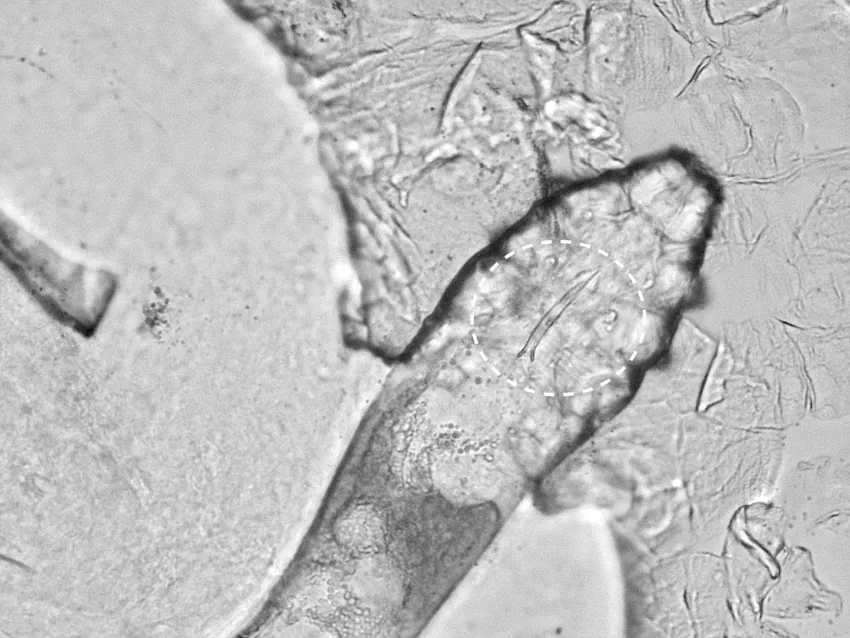They live in the pores of our faces by the thousands.
They have done so since the dawn of humankind, scientists say.
We get them from our mothers immediately following birth, and they stay with us until we die.
At night, when we’re sleeping, they come out of those pores and mate..
Then they go back home and lay their eggs.
Things have been so good for these tiny critters — from their perspective — that it’s caused a problem: Genetically speaking, they’ve grown complacent — and they’re heading down an evolutionary dead end.
One day, they’ll be likely to be gone, and we’ll be sorry.
So says a recent study of the genome sequence of Demodex folliculorumor follicular mites, the microscopic arachnids — related to ticks and spiders — that live on just about everyone’s face.
Don’t bother looking for them in the mirror. D. folliculorum are only about a third of a millimeter long. You’d have to lay five of them end to end to stretch across the head of pin.
They spend their days — head down, butt up — in hair follicles, cozied up against the shaft of the hair that grows from there.
Most mammals have a few species of face mites—dogs and cats have three or four, humans just two—and as near as scientists can tell, they’ve been with us since the evolution of Homo sapiens.
They are arguably, scientists say, the animals with which we have the most intimate interactions, despite the fact that most of us will never see one in our lifetime.
But as time has passed, our mites have succumbed to the “use it or lose it” principle. They’ve found such a welcoming environment on our faces that many of the adaptations that they had — that free-living mites still have — have become unnecessary.
And so, their gene sequence, over time, has become the simplest possible version of itself.
“Because they have adapted to live inside the pore, they are no longer exposed to the environment outside the pore,” said Alejandra Perotti, associate professor in invertebrate biology at the University of Reading in the UK, and one of the lead authors on the paper.
“They don’t need a lot of those genes. And the moment they don’t use them, they start losing them.”
In a study published last week in the journal Molecular Biology and Evolution, Perotti et al. proposed that what they are seeing in the gene sequence is that the mites are in a transition stage from parasite to a symbiont: an organism that lives in a partnership with its host — us — from which both parties benefit.
Right now, the mites get food, a place to live and a place to have sex. And though they can sometimes, relatively rarely, cause skin problems for their hosts, they also do us a solid by keeping pores clear — they feed on sebum, an oily, waxy produced by the skin.
The gene sequencing shows that this relationship has progressed so well over the millennia that the mites have got rid of adaptations they no longer need.
Genetic reduction has simplified their structure so much, that their legs — all eight of them — are powered by just three single-cell muscles. They get by with the smallest number of proteins that scientists have seen in this species or any related to them.
They’ve lost the gene that causes animals to be awakened by daylight, which from their perspective, is a good thing, since they’ve also lost their UV protection.
They’ve also lost the ability to produce melatonin.
We humans secrete melatonin at dusk; among other things, it helps us to sleep. But for small invertebrates like our mites, it’s like Red Bull — it fuels their all-night mating sessions on your face.
And to that end, evolution has also moved their genitals in such a fashion as to make it easier to have sex within tight confines — like our pores, says Perotti.
But there’s an end point to this gene simplification, and that way may lead to the mites’ extinction. Perotti and her researchers have also found that the mites have lost the genes that help repair DNA, and surmise that this, coupled with the mites’ inbreeding — they don’t much get out to other people’s faces — might be leading to an evolutionary stalemate .
“They are going to a dead end, evolutionarily speaking, because there is only so much they can lose in terms of genes to be functional, to be alive,” says Perotti.
But they won’t reach that dead end anytime soon, she says, evolution being a process that occurs over many, many years. In the meantime, she suggests, we should learn to develop a meaningful relationship with our Demodex.
“We should love them. They are our animals,” she says laughing. “Some people like to have pets — well they already have something.”
“Some people will be shocked, but I hope they get the message that… they should take care of them. They should make them happy. It’s not difficult to keep healthy and clean skin and make the mites happy to keep helping us maintain the health of our skin.”
Which sounds like an emotionally healthy approach — if you can get over the thought of what they do on your face while you’re sleeping, that is.
JOIN THE CONVERSATION
